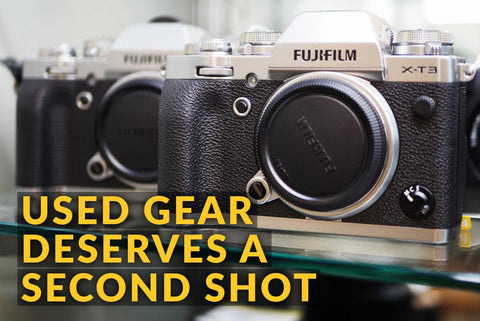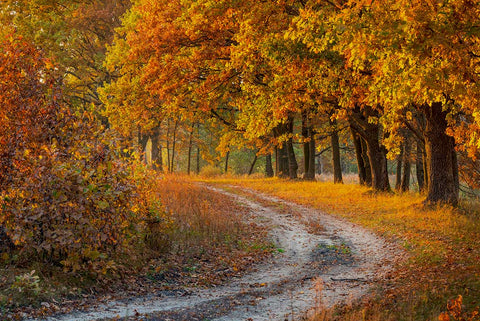Remember when photography was just about knowing how your camera worked and which film to use for the right occasion? Ok--we all know it's so much more than that! But now we're throwing all sorts of new camera types into the mix--like a mirrorless camera--and it's tough to keep them all straight...let alone know which one is right for you. Join us as we discuss both DSLR and mirrorless cameras and which is right for each type of photographer!
DSLR camera.
The DSLR camera is, on a basic level, the digital version of traditional film cameras. But instead of using film to control your ISO, you have digital control of it.
So let's dig deeper: DSLR stands for digital single-lens reflex, which uses a digital version of the single-lens reflex idea, where light passes through the lens and "reflects" (thus, reflex) onto a mirror to a pentaprism (or pentamirror) so that the photographer can see the image they will capture through a viewfinder. When we press the shutter button to capture an image, this mirror flips up to impress the image upon the camera's sensor, thus capturing the photo. Although this system is digital, it's not always as "fast" as we would like to perceive.
The reason many people moved from film SLR cameras to DSLR cameras is that many of the functions were digital and thus, indeed, faster. (And did we mention less expensive than buying all that film?) Being able to see ISO, shutter speed, aperture, exposure, and so on inside the optical viewfinder and change them on the fly did speed up the process. The mechanical shutter has become faster, which is shown in a camera's FPS, or frames per second. Not having to switch film in the middle of a shoot (which wasn't really possible without ruining the images already captured) became possible with a DSLR because ISO could be adjusted in-camera instead of being dependent on film.
Lenses are also a major appeal for DSLR cameras. Lenses like a 70-200mm f/2.8 lens allow for photographers to capture the action in less-than-stellar lighting conditions (like in gyms, etc.). A traditional point-and-shoot camera--even the higher end ones--can't match the speed and image quality that we can obtain with a DSLR and a high-performing lens.
Did we mention that most of them shoot video?
DSLR cameras are, however, larger in size. DSLR cameras tend to be heavier, as are some of their accompanying lenses. They may also seem bulky--so larger camera bags are necessary vs. slipping them into a pocket or small purse. Traveling with DSLR equipment is doable. But we can't forget the grumbling about the growing expense with airlines charging for additional carry-on bags.
The bottom line: DSLR cameras really help photographers capture better images, and the sky is the limit with what you can capture with added filters, lenses, off-camera flash, and so on!
Mirrorless camera.
The mirrorless camera is one of the newest to enter the camera world...and it's taken us by storm. Mirrorless cameras are different from traditional DSLR (digital single-lens reflex) cameras in that they don't have the mirror to reflect light up onto a pentaprism or pentamirror to aid in the photographer being able to see the image through a viewfinder. Instead, mirrorless cameras use the image sensor itself to focus and quickly display the image on the rear digital screen (or, in some mirrorless cameras, through an electronic viewfinder).
A major benefit of mirrorless cameras is that they are considerably lighter than DSLR cameras. The body size of a mirrorless camera is more like that of a point-and-shoot, so they fit in smaller hands, are easier to transport in smaller bags and purses--with the same image quality as their "bigger brother" DSLR cameras.
Because of its compact size and lack of focusing mirror, the mirrorless camera has sensors that have been manufactured to do more of the work and are considerably faster. This means it's often much easier to autofocus. Mirrorless cameras have fast video capabilities...many of which can follow focus (meaning they can follow a subject through action automatically versus manually focusing in video mode like with most DSLR cameras).
Mirrorless cameras now also come with an array of lenses to be a true competitor in the removable lens market. The lenses are smaller in size but not in quality both in construction and resulting images. Many of the lenses we find available for DSLR cameras are also available for mirrorless cameras as well. Don't want to give up your lenses from your DSLR? No problem! Many adapters are available so that you can use your current DSLR lenses on a mirrorless camera!
The bottom line: Mirrorless cameras are smaller, more compact, and easier to carry and have most (if not more) of the same features as traditional DSLR cameras.
Final thoughts.
While the mirrorless movement has been an industry changer--we have to hold on a minute. There are many advantages to both DSLR and mirrorless cameras.
A traditional DSLR has system capabilities, 3rd party lens manufacturers, and is more suited for those who want a larger camera. The smaller form factor isn't for everyone.
A mirrorless camera, however, is a smaller iteration of a DSLR and can actually complement a DSLR setup. Some people have BOTH! These photographers want a smaller system to travel with but still want their larger DSLR. Other photographers just want a smaller camera and have chosen to go with a mirrorless setup.
The camera world is competing with smartphones and their improving cameras--but many still want the exceptional images DSLR and mirrorless cameras offer. Visit our website for our selection of both mirrorless cameras and DSLR cameras.





